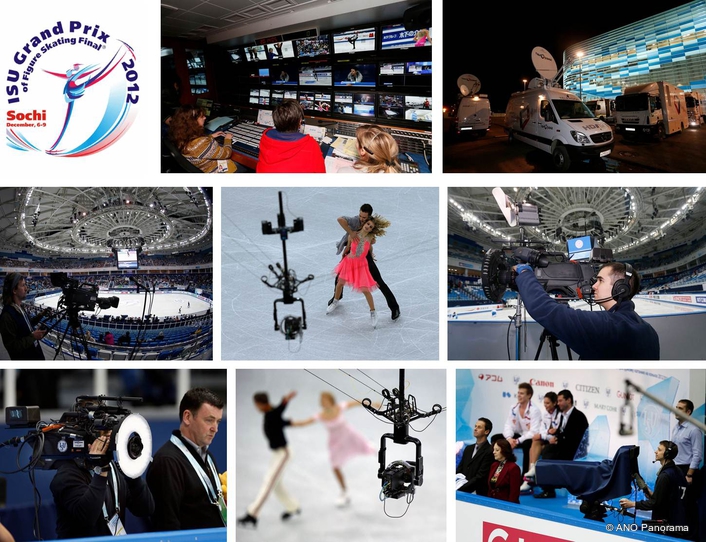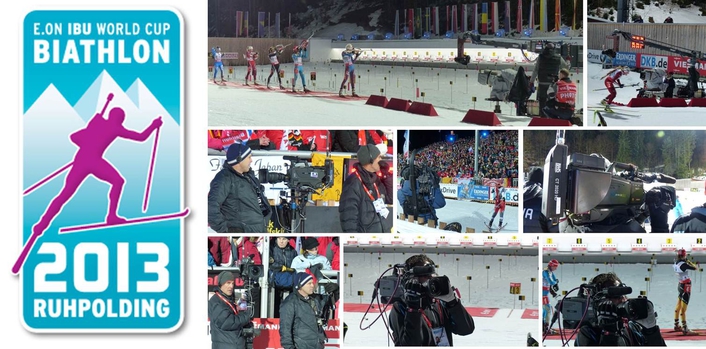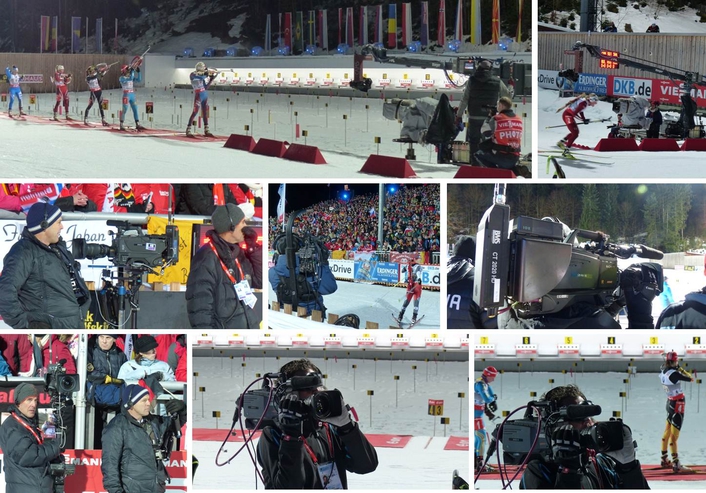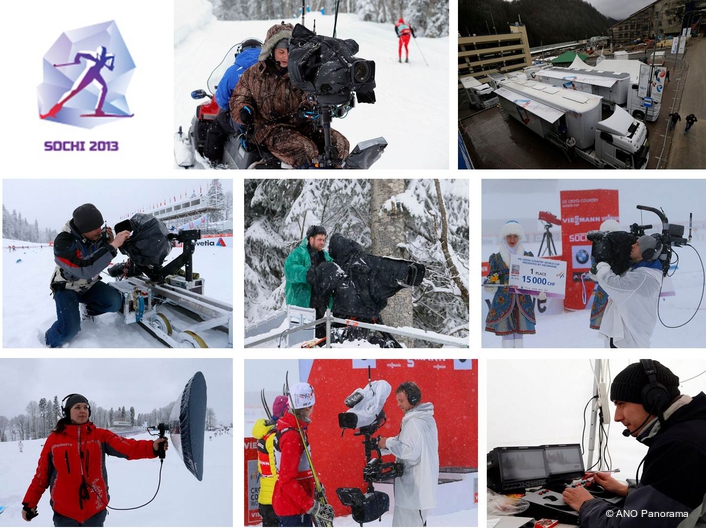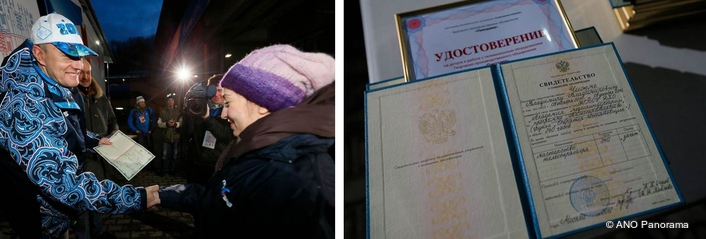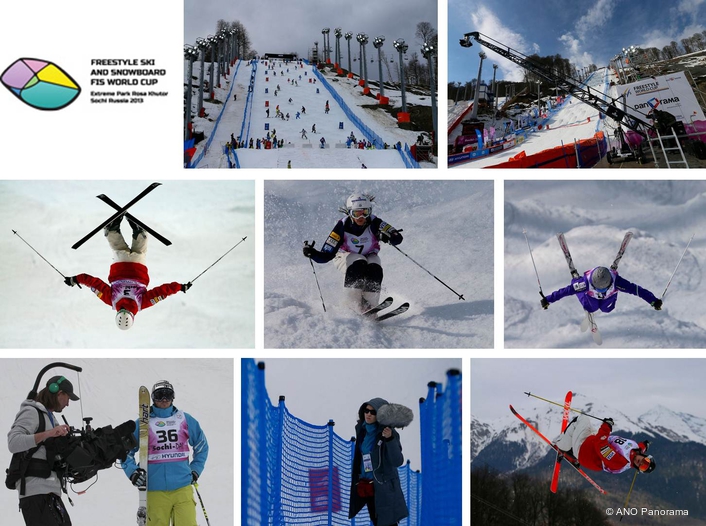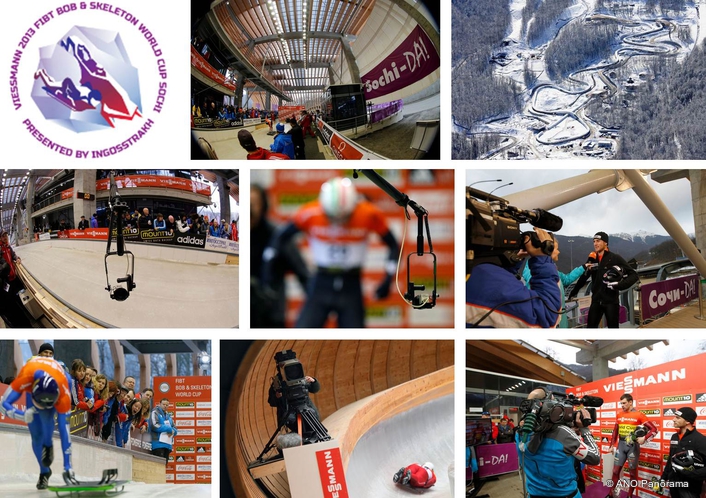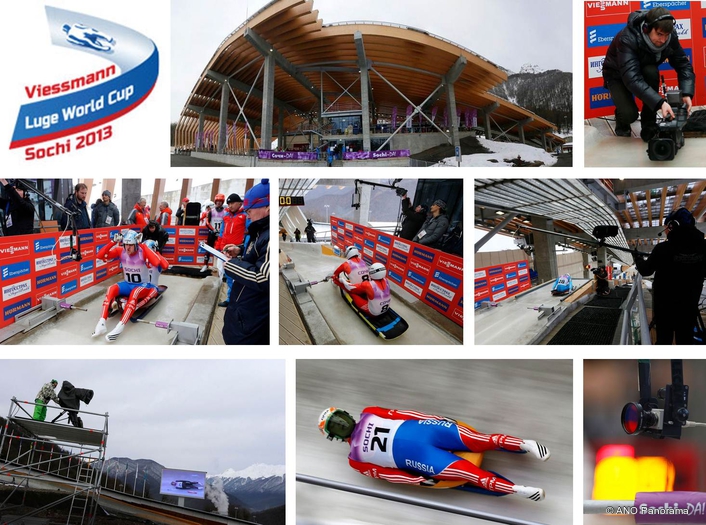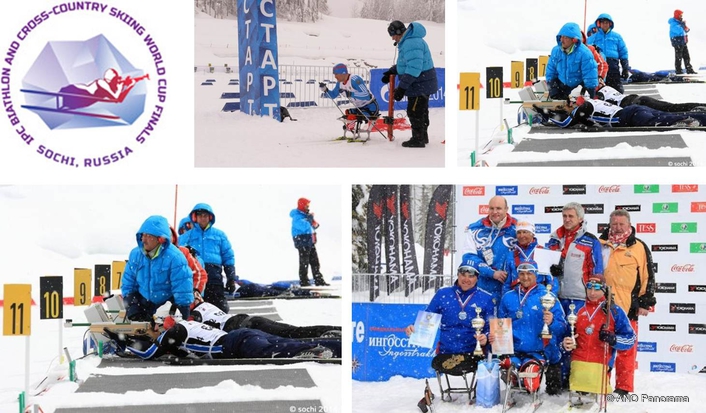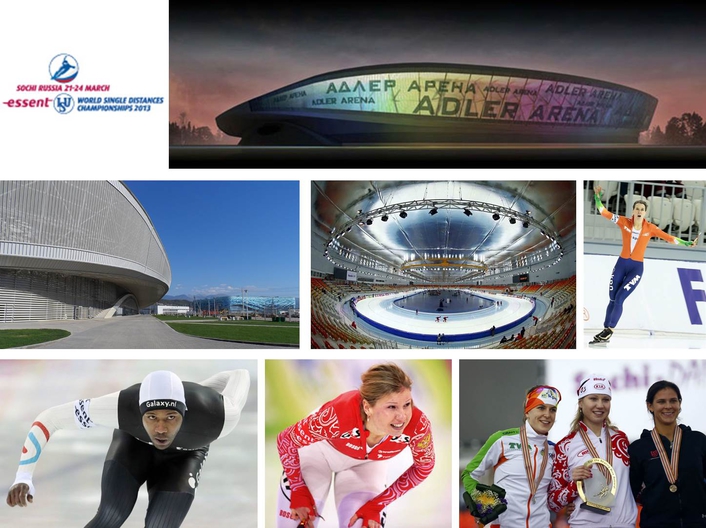On the Way to Sochi: Pre-Olympic Test Events covered by ANO Panorama
posted:
Live Broadcast of 17 Test Events in Sochi
ANO Sports Broadcasting (Panorama) was the host broadcaster for 17 test events in Sochi. Already in December 2012, Panorama produced the first two international events. The television signals of the Figure Skating Grand Prix (December 6-9, Iceberg Winter Sports Palace) and of the Ski Jumping World Cup (December 7-9, "Russian Hills") were shown to a worldwide audience.
advertisment
Live broadcasts of the competition were shown by all right holding broadcasters. Summaries and Highlights were available also online on http://RussiaSport.ru
The events were produced in HD by the crew of Panorama, which was consisting of 173 television professionals. For the production state-of-the-art TV equipment was used. The equipment was manufactured according to the technical requirements of Panorama by leading foreign and Russian manufacturers and system integrators. In particular, two 16-camera and one 10-camera HD OBVans, three DSNG vehicles, five mobile power systems, and special camera equipment was engaged. The unique Robycam system (“Spider-cam"), developed by Russian engineers, provided the opportunity to see skaters from the most spectacular angles.
ANO Sports Broadcasting CEO Vasily Kiknadze said, "The Olympic Games and the test events, for which we have purchased equipment and trained over a thousand television professionals, will help us make a great leap in the development of Russian sports broadcasting, and open the way to the HD format in Russia.”
advertisment
Grand Prix Finals in Figure Skating
The finals of the Figure Skating Grand Prix finished on December 9. The finals were visited by the Russian President Vladimir Putin, Jean-Claude Killy, Chairman of the Coordination Commission for the Preparation of the Olympic Winter Games in Sochi in 2014, IOC Executive Director Gilbert Felli, Head of the Ministry of Sports, Vitaly Mutko, and Head of the Olympic Committee of Russia and State, Duma Deputy Speaker Alexander Zhukov.
advertisment
The Iceberg Palace of Winter Sports, which hosted the event, is the first commissioned Olympic facility. The competition of the dancers tested the ice palace. The camera work here was also something new for the creative and production team of Panorama. During 6 – 9 December, television professionals, with high sophisticated equipment like HD OBVans, DSNGs, Mobile Power units and special camera equipment like the Robycam, covered thefinals of the Figure Skating Grand Prix for the rights holding broadcasters.
advertisment
Ski Jumping World Cup
The Ski Jumping World Cup was held from December 5 to 9 in Sochi. Athletes from all around the world tested the Olympic venues – a complex of ski jumps and trails for the Nordic Combined, called the “Russian Hills”. The TV shooting of the competition was made by the television crew of Panorama using a 10-camera and a 16-camera HD OBVan and additional television equipment.
advertisment
Exchanging Experience: Panorama Visits ARD in Germany
On January 8-13 a team of Panorama experts visited Ruhpolding, Germany to exchange experience in the broadcasting of major sports events. At the time, Ruhpolding was hosting the Biathlon World Cup.
advertisment
Panorama’s team met with the host broadcaster of the competition, Bayerischer Rundfunk which is a member of the ARD broadcasting company, and representatives of the International Biathlon Union as part of the preparations for the broadcasting of the Biathlon World Cup in Sochi, which took place from 7 – 10 March 2013. German specialists gave the Panorama team an opportunity to watch the entire setup process – from un-reeling the cables, set-up of the cameras along the track and visiting the operating HD OBVans from Bayerischer Rundfunk and TopVision.
advertisment
FIS Cross Country World Cup
On 1 – 3 February 2013 the Laura Cross Country Ski & Biathlon Centre hosts a stage of the FIS Cross Country World Cup. The host broadcaster ANO Sports Broadcasting (Panorama) was providing the international HD coverage of the event. Due to ongoing roadworks the HD OBVans could not go up to the Laura Ski & Biathlon Centre and therefore were placed at a broadcast compound about 2,5km away from the competition tracks. At the TOC (Technical Operation Centre) at Laura the signals coming in from all the camera positions located along the two race tracks with a total length of 5.75 kilometers were transferred via fiber lines to the TOC at the broadcast compound and further on to a 16-camera and a 24-camera HD OBVan. From here the cameras on the track were operated remotely.
advertisment
Before broadcasting the competitions, Panorama’s crew had done thorough preparation work. Preparations (un-reeling the cables, installing the equipment, etc.) started on January 26, and then the final run-throughs were conducted. Finally the first remote production of ANO Panorama was successfully completed.
Short Track World Cup
On February 1-3, 2013 the Iceberg Skating Palace hosted a Short Track World Cup event.Before broadcasting the competition, Panorama’s crew had done thorough preparation work which started on January 26. From 2 - 3 February a live transmission was provided with the help of a 10-camera HD OBVan and additional broadcasting equipment.
FIS Nordic Combined World Cup
On 2 February 2013 the RusSki Gorki Jumping Center in Sochi hosted the Nordic Combined World Cup competition. Despite challenging weather conditions, such as heavy rain, snow and thick fog, Panorama’s crew successfully delivered high-quality coverage of the event, giving a worldwide audience the opportunity to enjoy the thrill of the competitions.
Commencement Ceremony in Sochi
On 3 February during a break between the test events, there was a commencement ceremony at the Panorama TV compound at the Laura sports facility. Dmitry Chernyshenko, president of the 2014 Sochi Olympic Organizing Committee, and Panorama’s CEO Vasily Kiknadze presented 36 television specialists from Kaliningrad and St.-Petersburg with certificates for the completion of on-campus modules and e-learning courses.
The trainees who successfully completed the first stage of training were admitted to the Learning Portal for distance learning – with a special course for each of the eleven areas of knowledge. For example, the engineers had enrolled in a course on HD OBVans, Polecams and others. There were also courses like “Camera positioning and types of broadcast”, “LSM operations” and others. All these courses included practical exercises, case studies, and assessment tests. Interactive e-simulators helped to hone professional skills: the trainee was to act according to instructions on the computer screen.
The trainee was also allowed to choose his or her own schedule of training. The Learning Portal provided the trainee with all the information on education and its results, as well as the statistical data to help track his progress. It also hosted forums for different “degrees” to make the learning process more diverse and exciting, and provided an opportunity to communicate with other trainees and coaches, too. The Portal also offered webinars and a whole e-library of course books, manuals, additional literature, user manuals and video recordings of lectures.
The second stage was more practical. The trainees spent more than half of the course time with filming. However, it soon became clear that there wasn’t enough time to fully prepare for the shoot, and even detailed planning didn’t help much. For example, you cannot have three directors at one control desk. The trainees also had tutorials where they were supposed to solve cases. Both the coaches and the trainees were ready to work without any days off.
Thanks to training at Panorama, the Sochi Olympics will engage the best pros. After the 2014 Games, Russian regions will welcome proficient TV crews that would be working at large sports, political and cultural events. Their skills and qualifications will satisfy all the requirements for international broadcasts.
Snowboard World Cup at Roza Khutor Ski Resort
On 13 February the qualification rounds for the halfpipe started early in the morning at 9am. With a breathtaking double backflip Nikita Avtaneyev was placed 4th and the only Russian athlete to continue competing in the semifinal on 14 February.
ANO Sports Broadcasting (Panorama) continued its work as a host broadcaster providing international TV coverage of the event in HD format. Panorama’s team was operating 10-camera and 24-camera HD OBVans that accumulated and processed incoming signals from all the camera positions located across the competition area covering a total of 3000 meters of tracks.
Panorama’s specialists operated unique TV equipment, including the UltraSloMotion Phantom digital video camera that can capture 12 to 300 frames per second and thus provided a superb rendition of high-speed sports such as snowboard and freestyle. The camera can also operate in slow-motion playback mode.
Snowboard Parallel Giant Slalom World Cup
On 14 February the PSX Stadium of the Roza Khutor Ski resort hosted the full round of the parallel giant slalom competition, a winter sport that has been included in the Olympic program since 2002.
In the men’s competition, gold was claimed by Austria’s Andreas Prommegger, with compatriot Ingemar Walder coming in second, and Slovenian athlete Rok Flander finishing third. In ladies’s competition, Marion Kreiner of Austria finished first, followed by Germany’s Amelie Kober (second) and the Canadian Ariane Lavigne (third).
Russia’s best result this time was achieved by Ekaterina Tudegesheva who was placed 10th among the ladies. Among the men, Russia’s Aleksey Zhivayev was placed 16th.
Panorama provided the TV signal for major international broadcasters including Eurosport, ZDF and SRF. NTV PLUS, Sport and Rossia-2 TV channels covered the Russian audience.
Freestyle World Cup competitions at Roza Khutor Ski Resort
The final testing competitions of the Snowboard and Freestyle FIS World Cup stage at the X-treme Park “Rosa Khutor” (Sochi) featured the freestyle moguls.
Panorama provided the TV signal for major international broadcasters, such as Eurosport, Sport Japan, MTV (Finland), ZDF (Germany) and CCTV (China).
Bobsleigh and Skeleton World Cup
From 15 – 17 February the Bobsleigh and Skeleton World Cup Stage took place for the first time at the “Sanki” Sliding Center in Sochi. Men’s Skeleton and women’s Bobsleigh took place on February 15th.
Panorama provided the TV signal for FIBT (FIBT - International Bobsleigh and Tobogganing Federation), using a 24-camera HD OBVan, two mobile power units and special TV equipment.
Wheelchair Curling World Championships
From 16 - 23 February the Wheelchair Curling World Championships were held at Sochi’s “Ice Cube” Curling Center as part of the test-run for the 2014 Winter Paralympics. It was the first Paralympic competition that was covered by Panorama.
Wheelchair curling started as a Paralympic sport at the 2006 Winter Paralympics in Torino. The first World Wheelchair Curling Championships was held in Switzerland in 2002.The Opening Ceremony of the World Wheelchair Curling Championship took place on February 16th; the first competition of the tournament was held later the same day.Ten combined teams took part in the competitions – men and women compete together. The participating teams came from Russia, South Korea, China, Slovakia, the USA, Scotland, Canada, Norway, Sweden and Finland.
Luge World Cup
Panorama continued its work as a host broadcaster by providing the international HD coverage of the Luge World Cup that took place at the “Sanki” Sliding Center in Sochi on 22 – 24 February.
The Luge World Cup was the 12th testing competition that was covered by Panorama. Dmitry Chernyshenko, President of ANO "Organizing Committee Sochi 2014" commented the work of Panorama: “We expect the Olympic Games to attract 3.5 billion viewers. They all will see what Panorama has covered so far. Your work and the way you have performed will be considered as some kind of a new standard throughout the next decades. So this is a huge honor and responsibility for you, because the world’s attitude towards Russia will depend on the quality of the coverage”.
The Luge World Cup has involved high-tech TV equipment, including a state-of the-art HD OBVan. All the camera signals from the 1,8000 meter long track were available at the vision mixer in the truck where the director and the Panorama team produced the international TV signal.
All along the track at places which were inaccessible for cameramen, Panorama had installed 16 remotely operated mini-cameras: these cameras allowed the TV viewers to see the track the way the athletes see it.
Biathlon World Cup
From 7 – 10 March 7-10 the Biathlon World Cup took place at the "Laura" Cross-country Ski and Biathlon Center.
Panorama again was working as the host broadcaster providing the international HD signal of the event. Some unique TV equipment was involved – a camera on a hot head was set up at the shooting range and allowed the TV viewers to watch the flight path of the bullet before it was hitting the target.
Due to the ongoing roadworks the HD OBVans could not go up to the Laura Ski & Biathlon Centre and therefore again were parked at a the temporary broadcast compound about 2,5km away from the competition tracks. At the TOC at Laura the signals coming in from all the camera positions located along the race tracks with a total length of 4 kilometers were transferred via fiber lines to the TOC at the broadcast compound and further on to the HD OBVan. From here the cameras on the track were operated remotely. The Panorama team was using the fibre lines already installed for the cross country events in February and finally the second remote production of ANO Panorama was successfully completed.
The event was broadcasted by Eurosport, ARD/ZDF, VGTRK and NTV-PLUS channels.
Paralympic Alpine Skiing World Cup Finals
Sochi’s RusSki Gorki Jumping Center hosted yet another one in a series of trial competitions on 8 – 11 March: the final runs of the Paralympic Alpine Skiing World Cup.The first event was men’s and women’s Downhill. On March 9, Paralympic athletes competed in Super-G and Slalom.
The host broadcaster Panorama covered the events with cutting edge equipment. Spectators got the intensity of the sporting contests from start to finish. The HD broadcasts of the events was produced for all the rights holding broadcasters including Europsport, ARD/ZDF, VGTRK and NTV Plus.
IPC Cross-Country and Biathlon Paralympic World Cup
The Cross-Country and Biathlon Ski sports first appeared in the Paralympic program in 1976, at the Winter Games in Sweden. Men and women competed in the classical style only to cover all the distances. However the skating style was brought in for the first time at the Paralympic Games in Innsbruck in 1984. Since then the events have been broken down into two separate races: "classic" and skating style. The cross-country skiing events take place over distances between 2.5 and 20 km. The athletes are divided into three classes:
· LW 2-9 - athletes with physical disabilities;
· LW 10-12 - seated athletes (with a damaged skeletomuscular system);
· B 1-3 - athletes with impaired vision.
Medals are awarded in each of the categories and in each discipline. Depending on their functional disability, the athletes can use a sledge, consisting of a bob and an attached device with two skis. Athletes with impaired vision compete along with a leader who guides them.
In the biathlon events, each athlete is allowed to fire five shots. The distance is 10 meters. The penalty for missing the target may take the form of a time penalty, which is added to the athlete's final time, or a penalty lap. The shooting is carried out from the lying position. Blind and visually impaired athletes use a weapon fitted with electric acoustic goggles.
Essent ISU World Single Distances Speed Skating Championships
The «Essent ISU World Single Distances Speed Skating Championships» from 21 - 14 March featured all the competition events enclosed in the program for the Sochi 2014 Olympic Winter Games. 12 sets of medals were contested at the event, but the competition schedule had been compressed into four days, unlike at the Games, where there will only be one distance for the athletes to take part per day.
In the individual competition disciplines all the speed skaters start in pairs, each in their own lane, and alternate on each lap in the distance on the crossing straight. In the team discipline - the team pursuit - only the eight strongest national teams are allowed to take part. The teams compete in groups consisting of three speed skaters, and these three can take turns to lead the group - however, the result is determined when the third-placed athlete crosses the finishing line. There are no changes of lane in the team pursuit races, and the start takes place on the two straights of the ice rink, located opposite one another.
The pairs for each race and the order in which they start, for each distance and in the team pursuit, are determined by a special draw procedure. The winner is the skater (or team) with the best time at the finish, regardless of which race they skated in. The winner in the 500 meter race is determined based on the best aggregate time over the two races (each skater starts one race on the inner lane and another one on the outer lane).
Other Events taking place later this year
· Speed Skating World Championships 21 – 24 March
· IIHF Ice Hockey U-18 World Championships 11 – 21 April
· Invitational 4 Nations Ice Hockey Tournament 28 August – 3 September
Also for these three events Panorama will act as the host broadcaster.




